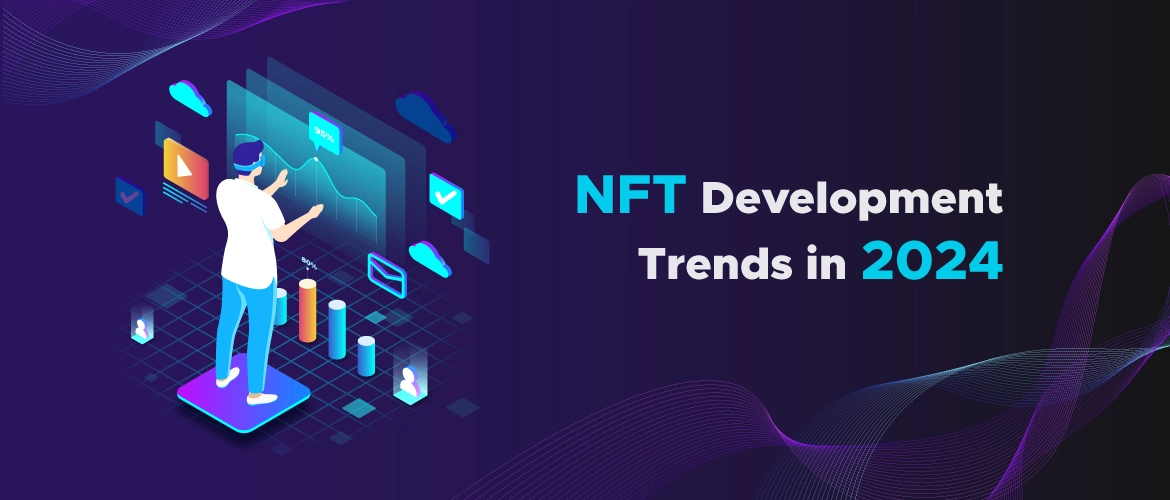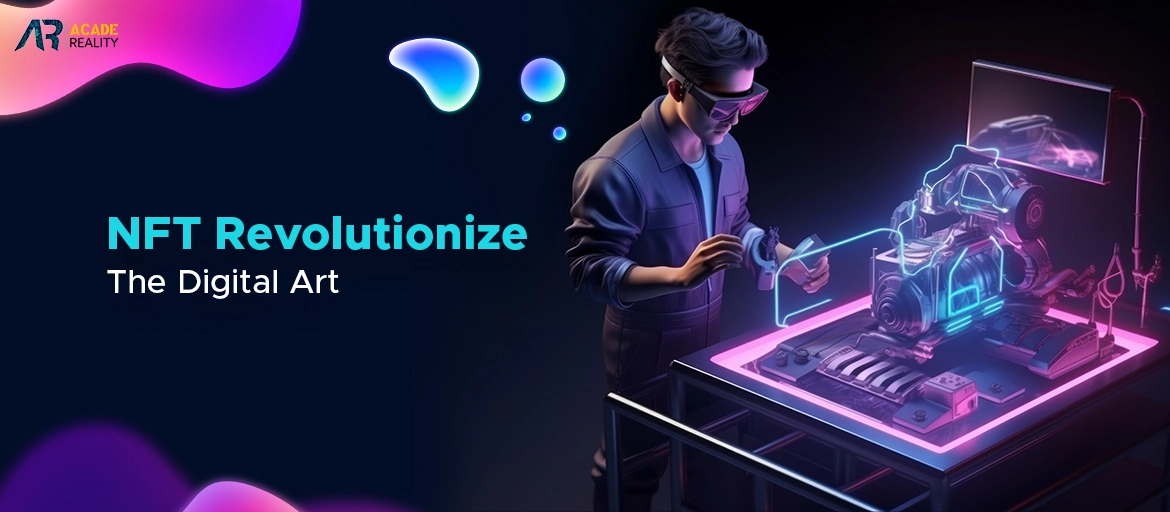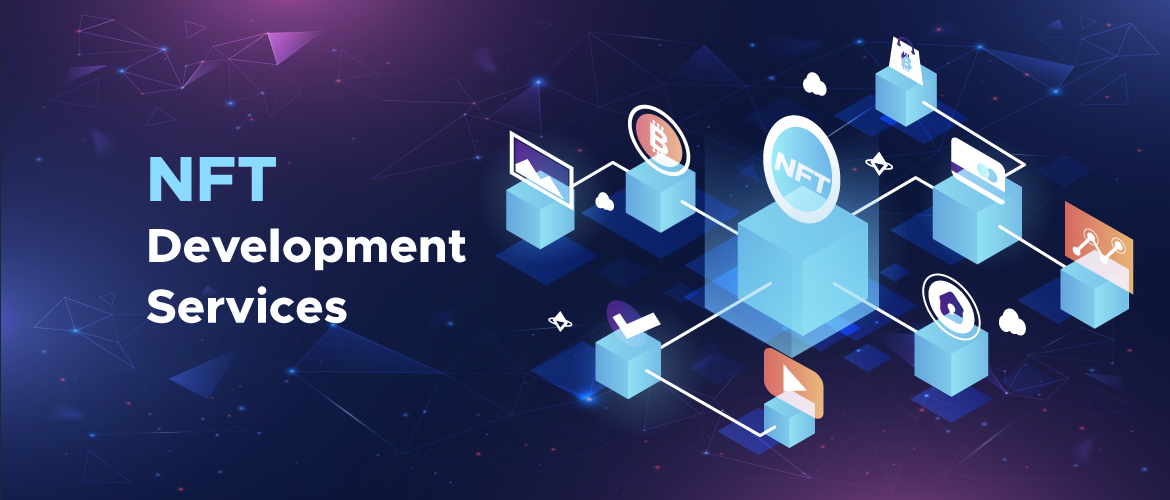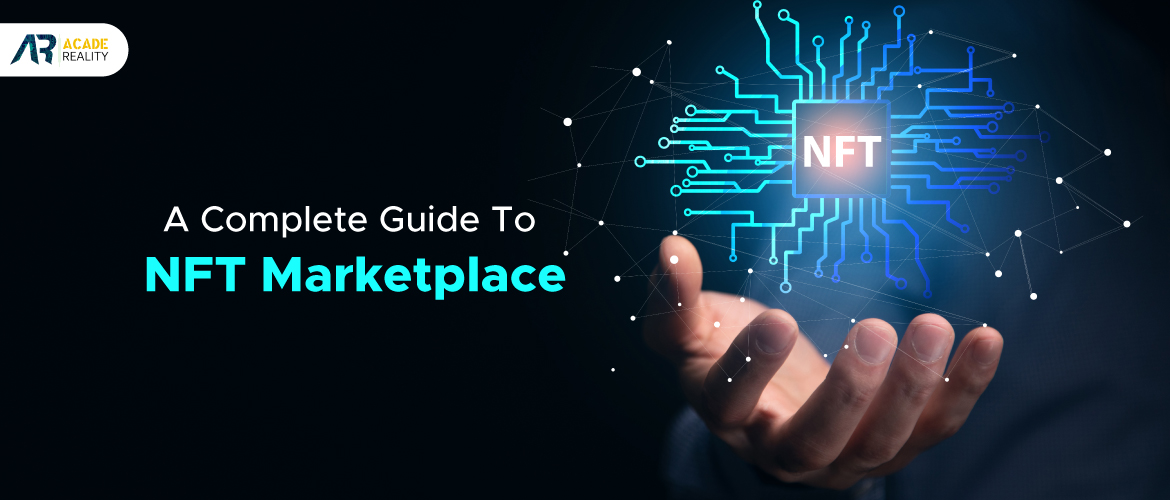NFT Development Trends to Watch in 2024

Non-fungible Tokens (NFTs) have arisen as a new trend in the ever-changing domain of digital assets and blockchain technology. These one-of-a-kind digital tokens are transforming the way we think about and trade digital assets. NFTs are used as a physical representation of ownership for digital assets such as art, music, collectibles, and virtual real estate, all made possible by cutting-edge blockchain technology.
With the NFT market moving so quickly, businesses and marketers need to keep on top of the latest developments. In this blog, we'll take a look at the key NFT marketing trends that will shape the landscape in 2024.
Metaverse Integration: NFTs Beyond Art
The concept of the metaverse is no longer limited to science fiction; it is now an essential component of our digital existence. Non-fungible tokens (NFTs), which were first associated with digital art, are spreading into the metaverse. The tokenization of virtual real estate, avatars, and in-game assets is creating new opportunities for investors, gamers, and creators alike.
1. The Evolution of Virtual Real Estate
In 2024, we are going to see more people buying and selling virtual land in the metaverse using NFTs. The metaverse is a fun and fascinating digital environment where having virtual land is similar to investing in real estate. Some entrepreneurs are already establishing their businesses in virtual areas, increasing the demand for distinctive and uncommon digital property.
The NFT development patterns projected in 2024 will have a significant impact on how virtual real estate is exchanged, purchased, and even created. The entities that specialize in this new industry, known as NFT Development Companies, will play a critical role in determining the future of the metaverse.
2. NFTs in Gaming: Play-to-Earn and Beyond
Gaming has grown into an important factor in the world of Non-Fungible Tokens (NFTs), and the trend will continue to expand even more in 2024. The concept of play-to-earn models, in which gamers can earn and exchange NFTs while playing games, is gaining traction. Game creators are rapidly using blockchain technology to verify actual ownership of in-game assets. As the demand for NFT services and blockchain integration in gaming grows, 2024 is projected to witness a significant growth in the number of NFT development companies dedicated to delivering novel solutions for the gaming industry.
This not only empowers players by allowing them to own and sell valuable in-game assets, but it also opens up new revenue streams for developers, bringing in a dynamic era of NFT-driven gaming experiences. Imagine playing your favorite game and earning valuable assets that can be bought or sold - this is the basic idea of the play-to-earn revolution. In 2024, game creators will continue to use blockchain technology to tokenize in-game products, characters, and possibly entire game worlds. Specialized NFT development firms will play an important role in forming this revolutionary landscape.
3. Environmental Sustainability: Green NFTs
Concerns have been raised about the environmental impact of blockchain technology, particularly in the context of NFTs. The growth of green NFTs will be a prominent trend in 2024 as the sector matures. Innovations in consensus algorithms and the adoption of eco-friendly blockchain networks, pushed by NFT development companies, especially those committed to sustainable practices will be important in directing this shift towards sustainability.
NFTs with a Conscience
Nowadays, environmental sustainability is more than just a catchphrase. NFT projects are actively investigating ways to reduce their carbon footprint with the help of companies that provide NFT services and who specialize in eco-friendly solutions. Platforms are shifting to proof-of-stake (PoS) and other energy-efficient consensus mechanisms.
1. Fractionalized NFT Ownership
In 2023, fractionalized NFT ownership emerged as a game changer, making high-value NFTs available to a broader audience. Individuals can now own fractions of sought-after digital assets, breaking down barriers and encouraging more people to engage in the dynamic NFT market. Fractionalized ownership democratized access and made the experience more accessible by allowing anyone to share in the excitement and value of highly valued NFTs.
Looking ahead to 2024, NFT development patterns are expected to impact the environment further. NFT service providers and development firms will play an important part in driving innovation by focusing on improving user experiences, extending utility, and exploring new use cases.
2. Enhanced Metadata and Dynamic NFTs
In the world of NFTs, metadata has grown increasingly important. Developers are now working on ways to make metadata more dynamic and interactive. Traditionally, metadata is intended to provide information about an NFT. This means that an NFT can change and adapt over time as a result of external circumstances or user interaction.
For example, consider a situation where an artist creates an NFT that changes appearance according to the viewer's location or the time of day. This dynamic function provides a unique twist to NFTs, making them more appealing to collectors. Improved metadata not only increases the value of individual NFTs but also opens up new creative avenues for artists and developers.
3. NFTs Inspired by AI
AI has the potential to alter NFTs through personalized and creative transformations. Consider this: NFTs that comprehend and adapt to your preferences, evolving and creating one-of-a-kind artistic expressions, particularly for you. NFT experiences become personalized according to your specific preferences and interests. This means a more immersive and engaging connection tailored just to you.
AI enters the realm of NFTs, creating unique and ever-changing creative forms. Through NFTs, this not only expands the possibilities for artistic expression but also pushes the bounds of creativity.
4. Decentralized Finance & PFP NFTs
Profile Picture NFTs (PFPs) and Decentralised Finance (DeFi) are becoming increasingly essential in the world of digital assets. PFPs, which are similar to avatar-based NFTs, are gaining popularity because they connect individuals who have similar interests and identities. This not only fosters a sense of belonging but also strengthens ties among those who own these NFTs.
What's more fascinating is the combination of PFPs and NFT-fi, which offers fresh and inventive financial options. DeFi mechanisms such as lending, borrowing, and fractional ownership can be employed with PFP NFTs to unlock their economic potential. This not only increases financial prospects but also allows producers to profit from their work and allows collectors to invest in precious digital assets.
Innovative NFT Ventures: How Industry Leaders are Pioneering the NFT Landscape in 2024
1. McDonald's: NFTs with a Side of Fries
McDonald's is investigating the potential of NFTs to improve customer engagement and loyalty. McDonald's reportedly plans to explore NFT projects in 2024 that incorporate tokenized digital valuables, possibly connected to marketing campaigns or exclusive events. The NFT Development Trends to Expect in 2024 may have an impact on McDonald's approach in this area. Think about purchasing a limited-edition NFT with your meal to gain access to unique digital content or discounts - a digital take on the traditional Happy Meal toy.
2. Nike: Stepping into the Metaverse
Nike, the world's largest sports footwear and apparel company, is lacing up its virtual sneakers and entering the metaverse. In 2024, Nike intends to launch limited-edition NFTs tied to limited virtual sneakers as part of its move into NFT services. These digital kicks will be more than simply collections; they may access additional features or experiences within virtual worlds, giving branded items a new dimension.
3. IBM's Cutting-Edge Blockchain Patents
IBM, an established technology business, demonstrated a keen interest in understanding NFTs by acquiring blockchain patents. This proved IBM's commitment to utilizing NFT technology for safe and secure information sharing. It also suggested that blockchain and NFTs aren't just for art and entertainment but may also be used to handle data in many ways. IBM's new strategy emphasized that NFTs might have a broader impact, particularly in data processing and security.
Sustainable NFTs: Shaping the Future of Digital Art
As NFTs grow more popular, it is very important to think about their environmental impact. In 2024, there will be a considerable emphasis on making NFTs environmentally friendly. Developers and platforms are working hard to discover long-term solutions, such as employing energy-efficient technologies and supporting programmes that reduce carbon emissions. The sector is getting ready to work towards high sustainability targets.
To accomplish sustainability, NFT platforms will come together with environmental organizations, deploy eco-friendly hosting options, and investigate carbon-offsetting programmes. The goal is not only to reduce the environmental impact of NFT transactions but also to contribute positively to global environmental initiatives.
The NFT community will likely make more efforts in the upcoming years to strike a balance between the appealing nature of digital assets and a dedication to a more sustainable and environmentally friendly future.
Conclusion
In 2024, the NFT industry is expected to grow and evolve even more. Cross-chain connectivity and augmented reality are becoming increasingly popular, particularly in the metaverse and gaming. These significant and positive shifts are affecting how we perceive and own digital content. Participating in this change entails more than just trying out a new way to acquire digital products. It also entails contributing to the development of decentralized systems. Ready for an exciting year filled with new ideas and important developments in the ever-changing realm of NFT!
You Might Like



